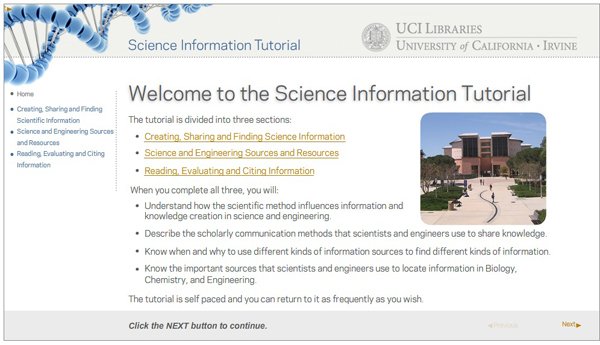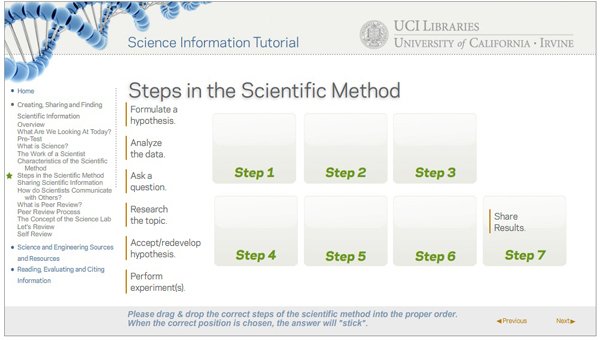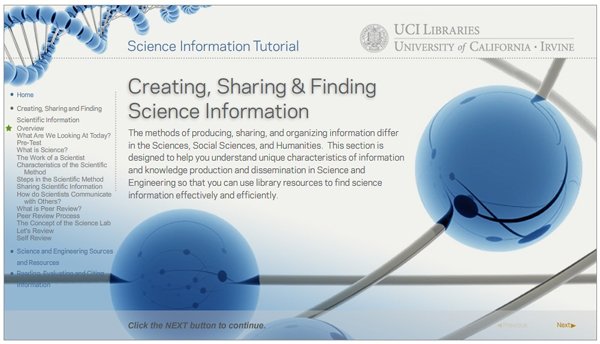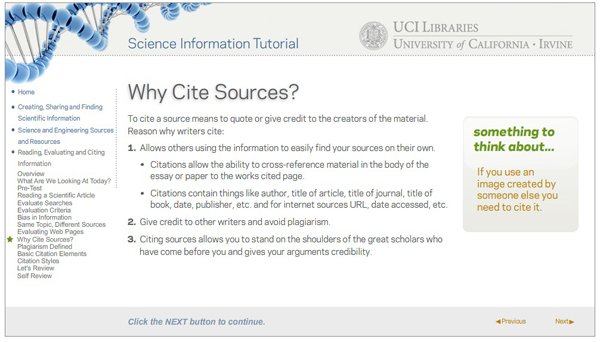An Undergraduate Science Information Literacy Tutorial in a Web 2.0 World
Science and Mathematics Librarian
Robert E. Kennedy Library
California Polytechnic State University
San Luis Obispo, California
jscaramo@calpoly.edu
Abstract
The development of an interactive web-based science information literacy tutorial that introduces undergraduate science majors to basic components of scientific literature is described. The tutorial introduces concepts, vocabulary and resources necessary for understanding and accessing information. The tutorial content is based on the Association of College and Research Libraries (ACRL) Information Literacy Competency Standards for Higher Education and the Information Literacy Standards for Science and Engineering/Technology (American Library Association (ALA) /Association of College and Research Libraries (ACRL)/Science and Technology Section (STS) Task Force on Information Literacy for Science and Technology). In order to engage students in a Web 2.0 world, the tutorial has evolved to incorporate interactivity, graphics, and self-assessment. This paper provides information on the development of the tutorial, examples from the tutorial, suggestions for future designers, and the next steps in development of the tutorial and web-based tutorials. This tutorial fills a gap in information literacy as professors are trying to provide more instruction in limited classroom time and provides a resource that can be assigned or reviewed throughout a user's college career, reinforcing information literacy principles. This is especially important for science majors who, unlike social science and humanities majors, may not need to use science reference materials actively until upper division classes.
Introduction
Many students arrive at college with no experience in using the primary scientific literature, but introductory science courses often spend little time on information literacy. Familiarity with the scientific literature and the ability to evaluate diverse sources of scientific information are important goals of science education. Identifying, evaluating, acquiring, and using information in science, engineering, and technology disciplines poses unique challenges. Much of science, engineering, and technology is now interdisciplinary and, therefore, requires knowledge of information resources and formats in more than one-discipline (ALA/ACRL/STS Task Force on Information Literacy for Science and Technology n.d.).
Information literacy is directly related to information technology skills. These skills enable an individual to use computers, software applications, databases, and other technologies to achieve a wide variety of academic, work-related, and personal goals. Increasingly, information technology skills are interwoven with, and support, information literacy (Association of College and Research Libraries 2000). However, information literacy extends beyond technologies and encompasses critical thinking (Perrault 2006). Given the need for greater knowledge about science and technology throughout the population, and the fact that the lives of today's learner's are deeply entwined with communications technologies and the online experiential environment, cyberlearning has reached the inflection point where real learning payoffs can be achieved (Borgman et al. 2008).
The library literature has paid considerable attention to web tutorials as an efficient means to deliver instruction in the use of online databases and other resources. However, libraries lag behind database producers and other vendors in development and use of interactive online tutorials. To catch up, librarians must overcome resource constraints and master the technology and software needed to produce tutorials (Jackson & Maddox 2004). The UCI Science Information Literacy tutorial was designed for undergraduate science and engineering students to bridge the science information literacy gap between high school and university and provide a foundation for life-long learning skills. The University of California Irvine (UCI) Science Information Literacy Committee developed a beta version of the tutorial, which was then revised and presented in an interactive, graphics-rich format.
Background
A UCI Science Information Literacy Committee consisting of education, reference, chemistry, biology and engineering librarians was charged with the task of creating a science information literacy tutorial for the campus. It has long been clear that collaboration between science and engineering faculty and the library (subject librarians, instruction librarians, web librarians and technology staff) maximizes the effects of any information literacy initiative (Saunders & Vreeland 2004). A faculty survey was developed and deployed to solicit opinions on the need for a tutorial and recommendations for its content (see Appendix A for survey questions). The survey revealed general agreement that the tutorial was necessary and general themes emerged for the content. The majority were also willing require the online tutorial as part of a course.
The tutorial content was created based on ACRL Information Literacy Standards for Science and Engineering/Technology. The educational librarian provided content appropriate to teaching basic information literacy principles, which subject librarians then adapted and augmented with science-specific components. Each librarian provided insight into the various scholarly publishing models, resource formats, and databases important in his or her subject area. The assembled content was initially presented in the standard UCI Libraries tutorial format: text in a basic PowerPoint slide format that allowed users to click forward and backward as they went through the screens. (The format used was similar to the majority of the academic library information literacy tutorials found online at that time, early 2007.)
After the tutorial was completed, feedback was solicited from science faculty before the tutorial went live (see Appendix B for survey questions). However, faculty provided very little feedback and conflicting views of the tutorial's success. We did make a few revisions and the final product had the content divided into five modules: Module 1: Introduction, Module 2: Overview of the Scientific Method and Scholarly Communication Process, Module 3: General Information Formats, Module 4: Locating Information, and Module 5: Evaluating Sources.
We then posted the tutorial, gave it "advertising" space on the libraries' home page, and asked for comments and feedback. At this stage, usage of the tutorial was extremely low. The tutorial used the educational objectives of knowledge, comprehension, application, analysis, synthesis, and evaluation integrated into the ACRL Standards as a foundation, but the resulting presentation contained a clearly artificial aspect (Budd 2008). We recognized that that a more effective presentation vehicle was needed to engage students with features such as interactive exercises, self-assessment, videos, and external links.
Creating a New Model
The tutorial has now been revised as described below to incorporate self-assessment tools including pre-tests, interactive exercises, and a self-review with opportunities for review and practice. The new tutorial includes three modules: (1) Creating, Sharing and Finding Science Information, (2) Science and Engineering Sources and Resources, (3) Reading, Evaluating and Citing Information. Links to other library tutorials and resources are also included (i.e., library catalog, subject guides, databases, Ask a Librarian).

The design of the new tutorial began with the collaboration of individuals affiliated with a number of departments and programs at UCI, including the campus distance learning program. Thus science information literacy educational experience, distance learning concepts, and technology were brought together for better delivery of the information to the user. The first version of the "new" tutorial was based on the text from the original PowerPoint with a new interface, graphics and interactive learning tools.
Learning science is something that students do, not something that is done to them (National Committee on Science Education Standards and Assessment, National Research Council 1996). Many educators have recognized that reading text is the primary and preferred mode of learning for only a small percentage of the population (Allan & Baures 1995). Today's students have an affinity for computers that can help facilitate their mastery of information literacy skills and their preferences tend toward visual and kinesthetic learning styles. Like all students, they learn more effectively when taught in accordance with their learning style preferences (Manuel 2002). By orienting toward images using interactive tools that provide feedback, students are able to explore the information actively, making them more engaged and invested in the material than if they were just reading more text (Manuel 2002).

Content and formatting were revised through three phases of usability testing. Students recruited for usability testing were excited to help and, as Manuel (2002) notes, "have incredibly positive views of technologies' potentialities and their own abilities with technologies." The students represented a variety of non-science and science majors at different stages of their college education. During usability testing, students were simply asked to go through the tutorial while a proctor observed their progress. As they progressed, the proctor recorded their comments and observations of their unspoken behaviors (e.g., trying to click objects on the screen that were not links, problems understanding how to proceed with an interactive tool, and verbal expressions of satisfaction, such as saying "yea" under their breath when they answered a question correctly). They were then asked a set of questions, such as: what did you like the best, what did you like the least, and what would you do differently. In particular, many students liked the section overviews indicating what they were about to learn in a particular section.

Usability testing provided valuable insight. The text presentation and density were changed; pre-and post- assessment were included; jargon was removed and words were defined; etc. It was clear from the usability testing that library and science terms that are commonly used by librarians and scientists are heard very differently by non-scientists. Thus, it was necessary to take care in how and where these words were used in the tutorial (Quinn 2007). In many cases, it was necessary to replace words that had caused confusion. Multiple users suggested changes for section headings. For example: the "test" at the end of a module was relabeled as a "self review" so that students would approach it without the negative connotations of a graded exercise.

A number of students asked for video and additional information "tidbits" to be integrated into the material. Thus, the revised tutorial incorporated YouTube videos made specifically for the tutorial on subjects such as reading scientific articles and evaluating web sites. "Factoids" (bits of valuable information on a topic that did not quite fit into the overview on that topic) allowed for serendipitous discovery of information by the student. These requests align with the idea of today's student's orientation toward images as part of holistic processing and nonlinear, consequential modes of learning (Webb 2006).

Three rounds of usability testing may seem excessive to some readers, but the final product was vastly different from the initial draft and more valuable for the user. We were amazed by the level of insight provided by the student testers. An important lesson learned in the process was to maintain a focus on the learning styles of the end users, the students, instead of the people providing the content, the librarians.
Discussion/Next Steps/Advice
The burden of integrating information literacy into science education falls on librarians because of our understanding of science education theories, pedagogies, and standards (Laherty 2000). This tutorial was designed for undergraduates and initially focused on science majors, although in its revised form it is appropriate for both non-science and science majors. It provides a general base for lifelong learning skills related to familiarity with science and health issues.
Strong partnerships with faculty are imperative for information literacy initiatives to succeed (Brown 1999). A quarter of faculty members perceive difficulty scheduling library instructional services into their courses (Leckie & Fullerton 1999). The necessity of faculty support for the integration of library instruction into their classroom activities cannot be overstated. As Webb (2006) said, "despite all of my planning, presenting, and other activities that went into developing this class, the most important of all would be promoting it to the faculty and students."
It is important to market to the faculty the idea that assigned viewing of the tutorials offers a way to increase the scholarly level of their students' assignments without taking away from class time. Similarly, the tutorial can be advertised to students via research guides and classroom instruction as a way to improve their understanding of the resources available to them and improve their grades. Notably, our usability testing subjects made it clear that they would not be as likely to use the tutorial unless it were assigned or offered as a way to get extra credit. [Students can e-mail or print a completion form at the end of each module.]
"Final" products such as this tutorial should not be static. It is important to plan and schedule ongoing revisions. Incorporation of multiple usability tests at various stages of completion is valuable to the development process, while continued usage tracking is valuable in assessing efficacy. Incentives can be given to end users for providing continuing feedback. Users can be motivated to provide comments by automatic entry into drawings for small prizes like university bookstore gift certificates. Before a product is considered to be complete, developers should analyze user feedback, assess usefulness to students and revise the tutorial.
Advanced material should be included in any science information literacy tutorial. Chemistry, physics, biology, engineering, and other fields have very different publishing models and information patterns. These issues can be discussed in detail without overwhelming the novice user by creating modular, subject-specific tutorials "attached" to the "general" tutorial using Camtasia or similar products.
Students are more receptive at the beginning of their academic careers, yet they require expert information-seeking ability as they progress in their programs. Therefore, the next step is to provide separate programs or modules for the beginner, intermediate, and advanced searcher. When creating library instruction programs, the importance of convenience, comfort, and time efficiency to the student audience should be kept in mind. Strong partnerships with faculty are imperative for these plans to succeed (Brown 1999).
The tutorial should be seen as organic and in need of revisions over time. The most challenging question is the evaluation and assessment of online learning. The comments and feedback from this tutorial are being collected at this time (encouraged by entering commenters into a drawing) to be analyzed in the near future. These comments will enable continuing improvement of this tutorial's effectiveness.
Appendix A
Scientific Information Literacy Survey (Fall 2006)Written by Cathy Palmer, Head of Education and Outreach Librarian, University of California Irvine
Appendix B
Science Information Literacy Tutorial FeedbackWritten by Jeanine Scaramozzino, (former) Physics, Astronomy and Mathematics Librarian, University of California Irvine
References
Allan, D.W. & Baures, L.A. 1995. B.I. Instructional Design: applying modes of consciousness theory, in The Impact of Library Instruction. Ann Arbor, MI: Pierian Press.American Library Association (ALA) /Association of College and Research Libraries (ACRL)/Science and Technology Section (STS) Task Force on Information Literacy for Science and Technology. n.d. Information Literacy Standards for Science and Engineering/Technology. [Online]. Available: http://www.ala.org/ala/mgrps/divs/acrl/standards/infolitscitech.cfm [Accessed: October 1, 2008].
Association of College and Research Libraries. 2000. Information Literacy Competency Standards for Higher Education. Chicago: American Library Association. [Online]. Available: http://www.ala.org/ala/mgrps/divs/acrl/standards/standards.pdf [Accessed: October 1, 2008].
Borgman, C.L., et al. 2008. Fostering Learning in the Networked World: the cyberlearning opportunity and challenge. Report of the NSF Task Force on Cyberlearning.
Budd, J.M. 2008. Cognitive Growth, Instruction, and Student Success. College & Research Libraries. 53(4):319-330.
Brown, C.M. 1999. Information Literacy of Physical Science Graduate Students in the Information Age. College and Research Libraries 60(5):426-438. [Online]. Available: http://209.85.173.104/search?q=cache:qJo6rf_2VwsJ:www.acrl.org/ala/mgrps/divs/acrl/publications/crljournal/1999/september99/brown.pdf+Information+Literacy+of+Physical+Science+Graduate+Students+in+the+Information+Age&hl=en&ct=clnk&cd=1&gl=us&client=firefox-a [Accessed: October 14, 2008].
Jackson, K.M. & Maddox, E.M. 2004. Evolution of a Chemical Literature Web Tutorial at Texas A&M. Special Libraries Association (SLA) Chemistry Division Web Conference, Teaching Users via the Web: Web-Based Training and Instruction in the Sciences. [Online]. Available: http://units.sla.org/division/dche/2004/maddox.pdf [Accessed: October 5, 2008].
Laherty, J. 2000. Promoting Information Literacy for Science Education Programs: Correlating the National Science Education Content Standards with the Association of College and Research Libraries Information Competency Standards for Higher Education. Issues in Science and Technology Librarianship, Fall. [Online]. Available: http://www.istl.org/00-fall/article3.html [Accessed: September 13, 2008].
Leckie, G.J. & Fullerton, A. 1999. Information Literacy in Science and Engineering Undergraduate Education: faculty attitudes and pedagogical Practices. College & Research Libraries. 60(1):9-29 .
Manuel, K. 2002. Teaching information literacy to Generation Y. Journal of Library Administration, 36(1/2):195-217.
National Committee on Science Education Standards and Assessment. 1996. National Science Education Standards. [Online]. Available: http://books.nap.edu/catalog.php?record_id=4962 [Accessed: October 3, 2008].
Perrault, A. M. 2006. American Competitiveness in the Internet Age
Report. Information Literacy Summit [Online]. Available: http://www.infolit.org/meetings/InfoLitSummit16Oct2007B.pdf [Accessed: October 10, 2008].
Quinn, H. 2007. Belief and Knowledge: a plea about language. Physics Today. 60(1):8-9. [Online]. Available: http://www.physicstoday.org/vol-60/iss-1/8_1.html [Accessed: February 26, 2007].
Rafkin, J. 2000. The Age of Access: the new culture of hypercapitalism, where all of life is a paid-for experience. New York, NY: Putnam.
Saunders, L . and Vreeland, C. 2004. Maximizing Value: Creating an Online Tutorial That Will Also Serve as a Reference Tool. Virtual Reference Desk (VRD) 6th Annual Conference. [Online]. Available: http://data.webjunction.org/wj/documents/12494.pdf [Accessed: October 1, 2008].
UCI Libraries, University of California Irvine. 2007. Science Information Tutorial. [Online]. Available: http://www.lib.uci.edu/services/tutorials/science_info_tutorial/tutorial.html [Accessed: October 3, 2008].
Webb, P. 2006. Meeting the Needs of Distance Education Students: creating an online-only library instruction course. C&RL News. 67(9):548-550.
Acknowledgements
I would like to thank my former co-workers for participating in the creation of this tutorial: the UCI Science Information Literacy Committee (Cathy Palmer, Mitchell Brown, John Sisson and Julia Gelfand), UCI Web Services (Mark Vega, Joe Chang, Johnny Lam and Kristine Ferry) and the UCI Distance Learning Center (Jia Frydenberg and Stacey Arnold). This work was supported with funds from the UCI Libraries Public Services Division. All screen shots are used with permission from the UCI Libraries.
| Previous | Contents | Next |
